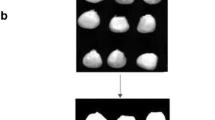Abstract
The nondestructive identification of the geographical origins of the seeds is a crucial step in the food industry. The seeds from near geographical origins are challenging to be separated due to identical climatic and agronomic conditions. The current study implemented the idea of combining near-infrared hyperspectral imaging (NIR-HSI) with machine learning to distinguish barley seeds concerning their geographical origins. Hyperspectral images of barley seeds from four near geographical origins were captured within the range of 900–1700 nm. Sample-wise spectra were extracted from the hyperspectral images and pretreated with different spectral preprocessing techniques, viz., standard normal variate (SNV), multiplicative scatter correction (MSC), Savitzky–Golay smoothing (SGS), Savitzky–Golay first derivative (SG1), Savitzky–Golay second derivative (SG2), and detrending. Unprocessed and preprocessed sample-wise spectra were given as input to four different machine learning models. Support vector machines (SVMs), K-nearest neighbors (KNNs), random forest (RF), and partial least squares discriminant analysis (PLS-DA) were used for the classification based on the 1D spectral features. Among these classifiers, SVM showed the best classification accuracy of 93.66% when applied with the SG2 preprocessing technique. The results revealed the significance of using hyperspectral and machine learning to make a clear, fast, and accurate difference among barley varieties based on their geographical origins.
Access this chapter
Tax calculation will be finalised at checkout
Purchases are for personal use only
Similar content being viewed by others
References
Hussain, A., Ali, S., Hussain, A., et al.: Compositional profile of barley landlines grown in different regions of Gilgit-Baltistan. Food Sci Nutr 9, 2605–2611 (2021)
Sohn, M., Himmelsbach, D.S., Ii, F.E.B., et al.: Near-infrared analysis of ground barley for use as a feedstock for fuel ethanol production. Appl. Spectrosc. 61, 1178–1183 (2007)
Wang, Q., Huang, M., Zhu, Q.: Characteristics of maize endosperm and germ in the geographical origins and years identification using hyperspectral imaging. In: 2014 ASABE Annual International Meeting. American Society of Agricultural and Biological Engineers, pp. 1–6 (2014)
Gordon, R., Chapman, J., Power, A., et al.: Mid-infrared spectroscopy coupled with chemometrics to identify spectral variability in Australian barley samples from different production regions. J. Cereal. Sci. 85, 41–47 (2019). https://doi.org/10.1016/j.jcs.2018.11.004
Zhang, T., Wang, Q., Li, J., et al.: Study on the origin traceability of Tibet highland barley (Hordeum vulgare L.) based on its nutrients and mineral elements. Food Chem. 346, 128928 (2021). https://doi.org/10.1016/j.foodchem.2020.128928
Giraudo, A., Grassi, S., Savorani, F., et al.: Determination of the geographical origin of green coffee beans using NIR spectroscopy and multivariate data analysis. Food Control 99, 137–145 (2019). https://doi.org/10.1016/j.foodcont.2018.12.033
Zhao, H., Guo, B., Wei, Y., Zhang, B.: Near infrared reflectance spectroscopy for determination of the geographical origin of wheat. Food Chem. 138, 1902–1907 (2013). https://doi.org/10.1016/j.foodchem.2012.11.037
Richter, B., Rurik, M., Gurk, S., et al.: Food monitoring: Screening of the geographical origin of white asparagus using FT-NIR and machine learning. Food Control 104, 318–325 (2019). https://doi.org/10.1016/j.foodcont.2019.04.032
Gao, J., Li, X., Zhu, F., He, Y.: Application of hyperspectral imaging technology to discriminate different geographical origins of Jatropha curcas L. seeds. Comput. Electron. Agric. 99, 186–193 (2013). https://doi.org/10.1016/j.compag.2013.09.011
Mo, C., Lim, J., Kwon, S.W., et al.: Hyperspectral imaging and partial least square discriminant analysis for geographical origin discrimination of white rice. J. Biosyst. Eng. 42, 293–300 (2017). https://doi.org/10.5307/JBE.2017.42.4.293
Sun, J., Lu, X., Mao, H., et al.: A method for rapid identification of rice origin by hyperspectral imaging technology. J. Food Process. Eng. 40, e12297 (2017). https://doi.org/10.1111/jfpe.12297
Singh, T., Garg, N.M., Iyengar, S.R.S.: Non-destructive identification of barley seeds variety using near-infrared hyperspectral imaging coupled with convolutional neural network. J. Food Process. Eng. 44, 1–13 (2021). https://doi.org/10.1111/jfpe.13821
Dai, Q., Sun, D.-W., Cheng, J.-H., et al.: Recent Advances in de-noising methods and their applications in hyperspectral image processing for the food industry. Compr. Rev. Food Sci. Food Saf. 13, 1207–1218 (2014). https://doi.org/10.1111/1541-4337.12110
Acknowledgements
The authors are grateful to National Bureau of Plant Genetic Resources (Delhi), Indian Institute of Wheat and Barley Research (Karnal, Haryana), University Seed Farm (Ladhowal, Ludhiana, Punjab), Rajasthan Agricultural Research Institute (Durgapura, Jaipur, Rajasthan) for providing the seeds.
Author information
Authors and Affiliations
Corresponding author
Editor information
Editors and Affiliations
Rights and permissions
Copyright information
© 2023 The Author(s), under exclusive license to Springer Nature Singapore Pte Ltd.
About this paper
Cite this paper
Singh, T., Sharma, A., Garg, N.M., Iyengar, S.R.S. (2023). Near-Infrared Hyperspectral Imaging in Tandem with Machine Learning Techniques to Identify the Near Geographical Origins of Barley Seeds. In: Tistarelli, M., Dubey, S.R., Singh, S.K., Jiang, X. (eds) Computer Vision and Machine Intelligence. Lecture Notes in Networks and Systems, vol 586. Springer, Singapore. https://doi.org/10.1007/978-981-19-7867-8_53
Download citation
DOI: https://doi.org/10.1007/978-981-19-7867-8_53
Published:
Publisher Name: Springer, Singapore
Print ISBN: 978-981-19-7866-1
Online ISBN: 978-981-19-7867-8
eBook Packages: Intelligent Technologies and RoboticsIntelligent Technologies and Robotics (R0)




